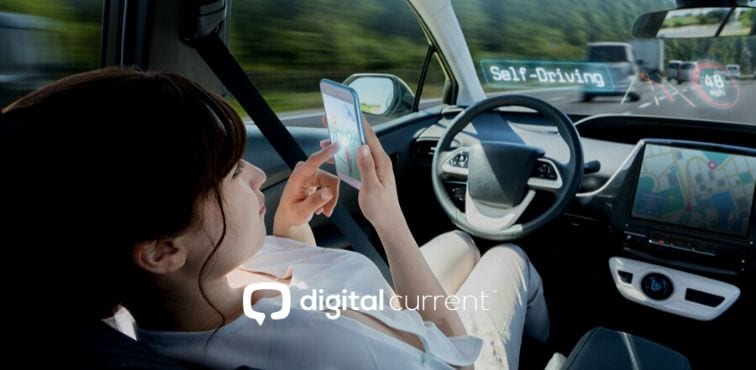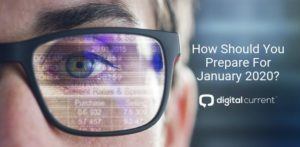How Will Driverless Cars Impact Digital Marketing?
Self-driving cars once seemed like a futuristic sci-fi fantasy, but their development is well underway. While everyone is still weighing the pros and cons of driverless cars, companies worldwide — including Google, Daimler AG, Tesla, Volvo, GM and Baidu, Inc. — have already begun developing autonomous vehicles, while public testing has happened in the U.K., France, Israel, China, South Korea and Japan. Testing in the U.S. has predominantly occurred in California and Arizona, where recently updated policies promise to ease the federal process for implementation. Estimates indicate that by 2030, one in every four cars on the road will be driverless. At Digital Current in Mesa, AZ, we regularly see autonomous vehicles testing on our streets. The future isn’t only now, it’s right here!
The corporate world is likely to adopt driverless cars first. As NPD points out, parents might be reluctant about trusting a driverless car with their children’s safety, while a company is not nearly as emotionally attached to the products they ship. For businesses, reliability and cost-effectiveness are more important.
Eventually, however, we should expect both corporate and personal driverless cars on the road. This could mean individuals who own their own automated cars — who might also elect to rent their car to individuals or businesses while they’re at work, out of town, or asleep — as well as people using automated rideshares. Rideshare giant Uber has already ordered 24,000 driverless Volvos to add to their fleet.
Just like the advent of computers, the internet and mobile phones, several industries stand to gain big with this emergent technology — or lose if they fail to adapt. Digital marketing is one of those industries, as digital touchpoints and time spent online increase as drivers remove attention from the road and redirect it to phones, tablets and in-car infotainment systems. That means more opportunities to get your brand in front of audiences, as well as a whole new frontier of activity- and location-based marketing. Federal safety regulations will undoubtedly pose limits that will change and evolve with the technology.
Computer Software, Security and IT Services
Just like smartphones and smart home devices, smart cars will require connectivity and programming. There are huge opportunities for new startups and existing companies to fit into the driverless car industry, be that in logistics, wayfinding, banking, entertainment or advertising. Brands must not only keep up with the technology to reach general consumers, but consider these new companies as possible clients in a B2B market.
Digital marketers must also be cautious, though, when it comes to privacy and security. Users will need to know that they, their data and their cars are safe from malevolent intent. Hackers should, of course, be prevented from gaining control over a driverless car. But as these smart cars carry sensitive information — including a passenger’s location, routines, and personal and financial information, all extremely useful to marketers — it’s imperative they remain secure. This creates a whole new market for data security firms and an unavoidable obstacle for digital marketing.
Companies like Trend Micro are already getting started. The cybersecurity and defense firm recently announced a partnership with Panasonic to defend autonomous and connected cars’ electronic control units (ECUs) from cyber attacks. This will undoubtedly pose challenges to marketers as they navigate new security technologies and laws surrounding autonomous car access.
Retail
For retailers hoping to connect with passengers using driverless cars — be it their own or a rideshare — targeted, location-based marketing will be key. If a smart car knows a passenger will be traveling through a particular area around lunchtime, perhaps dashboard consoles display a few suggestions.
Online retailers like Amazon have drastically changed the way consumers shop with features like same-day delivery and automatic refills. Instead of going to a grocery or department store for things like kitty litter and paper towels (and coming home with a dozen additional items they don’t need), customers may now set up an automatic delivery schedule for their necessities. This means a decline in both foot traffic and impulse buys as mobile shopping surges — yet, a huge opportunity for digital marketers to capture this audience’s attention. Brick-and-mortar retailers must compete, either by unique, in-store-only discounts or experiences (consider the rise of the Instagrammable, immersive “museum,” yet another digital crossover), or offering equal convenience; for these stores, the location-based marketing possibilities of autonomous, connected cars will be a lifeline to consumers.
According to the New York Times, Kroger has partnered with Silicon Valley startup Nuro to test a grocery delivery pilot program in a suburb of Phoenix — again, right in Digital Current’s backyard — using driverless cars. Store employees load up the cars with grocery orders, which are then delivered to customers for a $6 fee. In-store marketing loses effectiveness, then, leaving web portals as the ideal option for reaching a target audience.
For all retailers, driverless cars can offer a solution to the “last mile” problem, which is when people or goods must get from a central hub to their final destination. This is often the least efficient part of the entire process. While electric scooters like Bird and Lime solve the last mile problem for public transit users getting from a station to their workplace or home, autonomous vehicles could be the answer for commercial retailers. Human employees can focus on other tasks while self-driving cars and trucks take care of individual deliveries, thus alleviating the strain on human drivers — and opening them up to more productivity and screen time.
Financial Services and Banking
With connected cars, merchants and consumers will be able to enjoy literal mobile banking and payments. This could mean an enormous opportunity for doing business online; digital marketing will be key in cutting through the noise and snatching those quick-paying, on-the-move customers.
Experts predict that like modern-day phones, vehicles could be embedded with myriad apps and functions that make paying for products a seamless experience. Deliveries between businesses could be inventoried and paid for automatically, while consumers could authorize their cars to instantly pay tolls and parking fees or for fuel and purchases from drive-throughs. Passengers could also use voice-activated personal banking and financial management, including trading equities, meaning everything can be done on the go.
This technology is already in development, according to Accenture, which reports that hands-free, voice-authenticated apps are already in the works for this purpose from brands like Honda. Competitive retailers and businesses will adapt, while those who don’t may lose their tech-savvy, early adopting customers. That extends to marketing as well, as tactics must change to serve audiences interacting with content in a whole new way, including the ever-expanding realm of voice search.
Hotels and Air Travel
Air cargo is likely to decrease, at least initially, as commercial transport is transferred to autonomous vehicles. Trucking executives and drivers who responded to an annual survey conducted by the American Transportation Research Institute (ATRI) indicated that driverless trucks may alleviate a lack of drivers and electronic logging device (ELD) requirements, two common problems within the industry.
Of course, driverless technology will change not just how we move things, but ourselves as well. Passengers traveling shorter distances may eschew the hassle of airports and cramped planes for the convenience and comfort of a driverless car, especially if traveling by land becomes cheaper and safer. Volvo already has a concept car — the 360c — that the company suggests is the answer to short flights. Passengers can get some work done, enjoy a meal and custom entertainment, or sleep overnight while they’re ferried directly to their final destination. Travelers could go to sleep in Los Angeles, then wake up refreshed in San Francisco the next morning, all without having to deal with TSA — and if these travelers aren’t seeing highway billboards or airport advertisements, digital avenues will be key to reaching them. The convenience could be a boon for local travel. While passengers may sleep in their cars on the way, they may be inclined to take more regional, overnight vacations as traveling becomes more convenient.
What does this mean for the hotel and travel industries? In addition to more screen time, these new technologies will allow for more travel planning on-the-go, and targeted, location-based digital marketing will play a huge role here. As travel becomes automated — meaning easier, more accessible, allowing users to go farther and more often — digital marketers will gain more touchpoints with consumers, while needing to deal with a physically moving target with a much larger daily travel/commute footprint.
At Digital Current…
We always keep an eye on the future — and it’s nearer than most think. We stay flexible and agile, ready to pounce on new opportunities — like identifying reliable tactics to reach consumers utilizing driverless vehicles.


